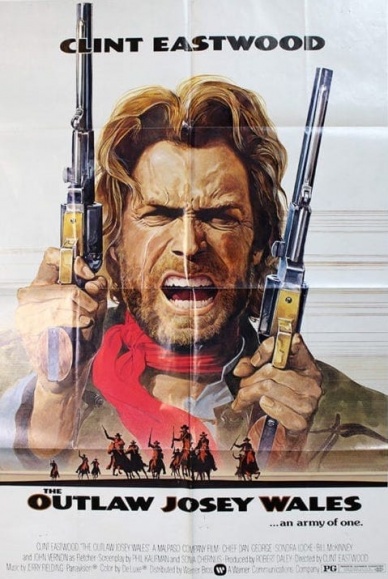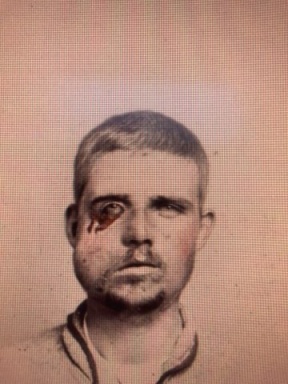On Tuesday, August 31, 2011, “Justice League” #1 dropped, officially beginning the experiment known as the New 52. DC Comics was not just relaunching all of its titles, it was doing so in a new, clean(er) continuity, in an attempt to revitalize and enthuse the fan base. It was an unprecedented move that bore good, bad, and mediocre comics.
Over the next year, we’ll be discussing each of the New 52 titles with a member of its creative team. We’re not taking any clear path through these books, but hopping from title to title, line to line, in an effort to spotlight the breadth of the initiative.
Today, we’re talking with Moritat. The veteran artist was coming off of “The Spirit” in DC’s ‘pulpverse’ when he got the gig on “All-Star Western.” Moritat was kind enough to send me a few reference photos he used which may be a little disturbing to some of our readers, as they are of soldiers who were disfigured in combat, so we wanted to issue a content warning, in case you think that may disturb you.
Moritat is on Twitter (@MoritatArt), and you can find a bunch of his original art for sale over at Cadence Comic Art.
This interview has been edited for length and clarity.

One of the things that I hear about the new 52 whenever I talk to anybody about it is that it came together super quickly. How did you get on “All-Star Western, And how long of a process was it from your first phone call to September when the first issue came out?”
Moritat: I was on “The Spirit,” and Joey Cavalieri was the editor. And that was its own little fiefdom. The book got cancelled and about, it seems like two weeks later, Joey, calls me up, he says, “Hey, wants you to do Jonah Hex?” And I don’t think they had quite decided on the the title yet. And I just thought it was a fill in issue. In subsequent calls, he was like, “No, no, no, no, this is an ongoing.”
It took me a while for them to say, “Hey, you know, it’s a, it’s a new relaunch.” I had, from what I remember, a good good amount of lead time. So it was, yeah, I was fine. The thing with me was, you know, gosh, “we’ve got one guy at DC who can draw trench coats and hats, you know, let’s put him on it.” And to this day, I can’t believe that I’ve never kind of followed up on that. “Like, why do you guys give me “The Spirit?” “Oh, you can draw hats!” Or, “why Jonah Hex?” “Well, we know you can do a cowboy hat.” Are you guys serious?
Did you have any affinity for Western comics at this point? Or was this just you know, like, they said, you can draw hats?
Moritat: I could draw hats. But the other thing is, there were probably a couple of drawings online that I’d done of Lieutenant Blueberry, from these French graphic novels. And I guess people knew that I was a big fan of Moebius. I never really got the inside scoop on some of the ‘secret origins,’ but I know there was another artist considered before I was.
Now, you were one of the artists that stuck around the longest. From the first issue. I want to say you left in like the mid 20s 25,26, something like that. Did you feel there were more editorial conversations, changes, etc. than on other stuff you’d worked on in the past? Because again, the sort of the rumor out there is that editorial was sticking its nose into everything more so than it had in the past? Was that your experience on “All-Star Western?”
Moritat: Okay, you’ve you’ve you’ve stumbled on my favorite story here, which kind of kind of soured me on on “All-Star Western.” This is a golden gem. So at one point we were going along, I was talking more to Justin Gray. We would talk twice a week on the telephone about the story and everything. And Jimmy was off, you know, hustling and doing all this other, you know, important stuff. And Justin told me “Hey, you know, we’re going to do a time travel thing”. And he outlines that, you know, we’re going to go through time, we’re going to do some cool stuff. And Jonah Hex is going to go to World War II team up with Sergeant Rock and fight the Nazis. How cool is that? All right, you know what? So you know, I’m looking up German tanks on Google , there’s other [reference] stuff. And then we talked about it one or one or two more times. And I think…I would almost say, like 48 hours before I got the script. And when I got the script, I read it. I went through it and I’m like, “where’s Sgt. Rock?”. So I called Justin Gray, and said, “what the hell happened?” They wouldn’t let us use it. Like, they wouldn’t let you use it two days before you dumped the script. And he mumbled something. But he said, he alluded to that there was interference from Geoff Johns, and that Sgt Rock was a ‘Geoff Johns’ character., and that he had dibs on, and we weren’t allowed to play with. So there’s a juicy bit for you, right there.
Continued belowWe’ve all heard about the editorial meddling during this time. How often were you told you have to redraw stuff?
Moritat: You know, not not often at all. I think “All-Star Western” was a fourth week book, and they mostly left those alone. Because, you know, they didn’t really care what was going on with them. I mean, you know, there was no interference and up until the time travel arc, and then there was in then it just kind of got confusing. I’m like, “Okay, where’s this going?” You know, I’m just curious. If I have to draw something for the next issue, I’d like to prepare because, you know, I’m a little wiped out and tired. And all of a sudden, you know, they’d pop up something like, oh,”We can’t use Sgt. Rock, we’re going to use Rose and Thorn.” And they outlined a nice arc with Rose and Thorn, and we were going to discuss mental illness. And same thing, when the time came, the characters weren’t in the script. And I was like, “man, they they change that quick?” I can feel there was definitely more pressure, but I was mostly removed from it. So it was just, they would spring stuff on me that we discussed, and I’ll do some research, or I’ll get ready. I remember they were in a car. And I was like, okay, you know, what artists have no problem drawing cars, you know, so you download a SketchUp model, and you trace it and try this and that, but it doesn’t look that good. And then you know, and then they spring a different car on me, or something like that. That’s how I remember.
Now, the book lasted quite a long time, in terms of New 52 successes. Some books lasted eight issues, even more lasted only 12. The book got over 30 issues. Do you attribute that to somebody at editorial really liking the book, because it was selling alright, but it wasn’t selling like gangbusters. You know, you wouldn’t expect a Western title to be selling like Batman, right, because there’s this very specific audience out there for it. So what do you attribute the longevity of the book to?
Moritat: There was a consistent team; it was me, Justin, and Jimmy, and we showed up every month and did our jobs. And we were left alone, I think they knew that the numbers would stay put. I don’t remember what they were in the mid 20s or lower, but 19,000 or so, I mean, it was before it was above the cut off line, which was like 15,000 [copies per month]. Yeah, so we, you know, we let it alone and then the point that I jumped off, I already knew that the book was going to end. So you know, I didn’t have a big problem with it; I don’t think they did either. There was a backup artist, Staz Johnson,who was great, and they just kept him and he walked right in.
What was your reason for jumping off the book when you did?
Moritat: One, I was exhausted. And I don’t think there was a direction. I mean, Jimmy knew how he wanted to end the book, which is great, but we were doing a bunch of stuff where you know, there wasn’t a story. So I think it was probably editorial interference. I think at that point, I’d gotten another offer somewhere. So I was like, this book’s gonna end and you know, and then I think I was asking around editorial, okay, if this book’s gonna end, you know, can I jump on “Animal Man” or, you know, “Cyborg” or another D list title where I can get left alone? No, we checked our roster: there’s no hats.
How, how easy was it for you to get down your Jonah Hex? What did you do to feel comfortable drawing that character because, you know, the facial scar is not the easiest thing to draw, and not the easiest thing to draw consistently. But I recently read the whole run again, and I sort of marveled at just how, how quickly you fell into your Jonah. Is there anything that was particularly challenging about him as a character?
Continued belowMoritat: That’s an interesting question. I think it was Joey Cavalieri who told me the basis of the character came from a movie poster for The Outlaw Josie Wales. Josey Wales has a scar that’s kind of prominent, but the reproduction of that actual poster, probably on newsprint, made it look a lot worse than it was.

When I was researching the book, I found a bunch of photographs from war wounds from World War One. And surprisingly, there’s a guy that had a very similar kind of scar pattern. I don’t know if whoever it was that kind of established the canon look of Hex saw it, but there’s a photograph out there that’s like, Wow, that’s pretty damn close.

That’s really interesting.
Moritat:You know, the droop in the eye? I had reference for him too, and after that, it was easy. I’ve mostly used a lot of the old Mathew Brady Civil War photographs to kind of get that rugged kind of look, you know, color kind of slightly frayed gun belts.

If you had gotten more time on the book, is there a Western character or a piece of the story that you really wish you got to draw? Is there a missing piece that you would have liked to have done for that book?
Moritat: Oh, yeah, there was a bunch of stuff. But, you know, we had set up a bunch of things earlier on in the book, and I was really hoping that we’d kind of come back to. Justin created a character called the Barbary Ghost; I love that character. And yeah, you know, and there’s this great background, and, you know, she’s mysterious, and I was waiting for them to show up again.






